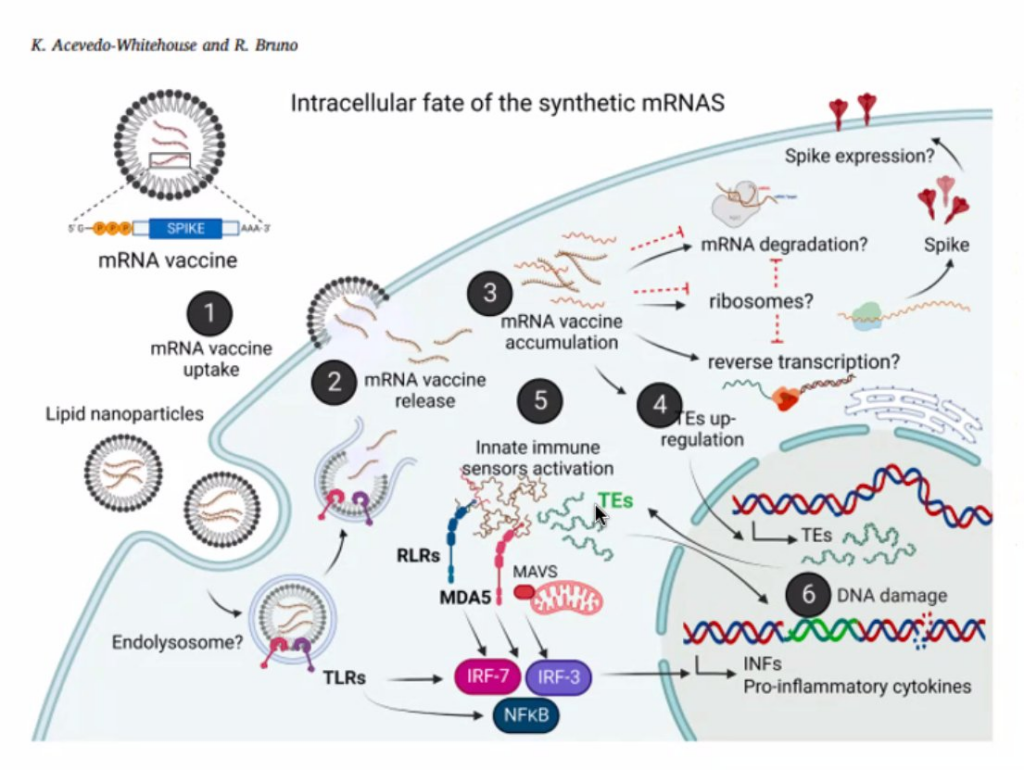Please read the following method I created to provide maximum safety for LNP and mRNA usage for treatments such as terminal cancers.
Guidance for Healthcare Professionals:
Safe Utilization of LNP and mRNA Technology Introduction:
This directive outlines a method for safely employing lipid nanoparticle (LNP) and mRNA technologies, particularly for treating life-threatening conditions such as terminal cancer, while minimizing associated risks to patient health.
System Overview Objective: To reduce risks associated with traditional direct administration of LNP-encapsulated mRNA, focusing on: Preventing the introduction of foreign particles into critical systems like the brain. Minimizing disturbances to the blood-brain barrier and synaptic functions. Reducing the incidence of myocarditis. Preventing resource depletion from the blood due to unregulated spike protein production.
Methodology:
In Vitro Preparation:
LNP and mRNA Introduction: Instead of direct injection, the LNP and mRNA are introduced into a controlled in vitro environment. This involves culturing cells or using cell-free systems where the mRNA can be translated into spike proteins without the risk of systemic exposure.
Spike Protein Extraction: Once expressed, the spike proteins are isolated from the cellular environment. This step ensures that only the desired therapeutic components are utilized, significantly reducing the risk of unregulated protein production.
Vaccine Formulation:
Purification: The isolated spike proteins are then purified to remove any cellular debris or other contaminants.
Saline Solution: The purified proteins are mixed with a sterile saline solution to create a vaccine or therapeutic agent. This approach ensures that the final product does not contain active LNP or mRNA but only the necessary proteins or antigens.
In Vivo Administration:
Injection: The prepared solution can then be administered to the patient, introducing only the spike proteins needed for immune response or therapeutic effect, without the risks associated with live LNPs or mRNA.
Risk Reduction:
Blood-Brain Barrier Integrity: By avoiding direct systemic circulation of LNPs and mRNA, this method minimizes the chance of these particles crossing the blood-brain barrier, thereby reducing potential neurotoxic effects.
Synaptic Function: The absence of LNPs in the bloodstream post-administration decreases the likelihood of interference with neuronal communication or function.
Myocarditis Risk: By not directly injecting LNPs, which can sometimes lead to inflammation or immune responses in heart tissue, the risk of myocarditis is significantly reduced.
Resource Depletion: The controlled production of spike proteins in vitro prevents the body from using its resources inefficiently, thus avoiding the potential depletion of vital components in the blood used for protein synthesis.
Contraindications:
Avoid Direct Use with Certain Pathogens: Do not use this method for pathogens like bird flu where the spike proteins could facilitate binding and infection. The introduction of proteins that pathogens can easily bond to could exacerbate infection risks.
Conclusion:
This approach to using LNP and mRNA technologies offers a safer alternative by isolating the therapeutic component from its potentially harmful delivery system.
This method should be considered for conditions where the balance of risk versus benefit leans heavily towards treatment, such as in cases of terminal cancer, under stringent clinical oversight. Note: This system is experimental and should be implemented with full ethical review, informed consent, and under conditions where alternatives are not viable or have been exhausted. Continuous monitoring for unforeseen effects is crucial.
Creating a metal-free system for the production, monitoring, and delivery of LNP (Lipid Nanoparticle) encapsulated mRNA vaccines using hardened glass involves integrating several advanced technologies, particularly in microfluidics, AI-driven automation, and advanced microscopy. Here’s how each component could be envisioned:
System Components:
Microfluidic Devices for LNP and mRNA Interaction:
Hardened Glass Microfluidics: Develop microfluidic devices from hardened glass to ensure no metal contamination. Glass-based microfluidic systems have been used for LNP production due to their durability and compatibility with biological processes. These devices would facilitate the precise mixing of lipid solutions with mRNA in the presence of blood samples in vitro. The glass should be treated to be biocompatible and inert to biological materials.
Blood Collection and Mixing: Use glass syringes or microfluidic devices for drawing blood to ensure no metal contact. The blood would be introduced into the microfluidic chamber where it mixes with LNPs containing mRNA. The mixing should be controlled by AI to optimize conditions like temperature, pH, and flow rate for mRNA expression.
Monitoring and Quality Control with AI:
AI Monitoring: Implement AI algorithms to monitor the production of spike protein within the LNPs. This involves real-time analysis of the mRNA translation process by assessing protein expression levels. AI can use data from spectroscopy or fluorescence-based detection systems to determine when the desired PPM (parts per million) of spike protein is achieved.
Image Analysis: Advanced microscopy techniques like confocal or fluorescence microscopy can be used to visualize protein expression directly in the microfluidics setup. AI can analyze these images to quantify protein production and ensure quality control.
Separation and Purification:
Micro Suction System: After achieving the target spike protein concentration, a micro suction system or a series of microchannels could be used to remove excess LNPs, mRNA, or cells. This system could employ size exclusion or affinity-based separation techniques, enhanced by AI to control flow dynamics and optimize separation efficiency.
Final Preparation and Delivery:
Saline Mixing: Once purified, the spike protein would be mixed with a non-toxic saline solution within the same microfluidic environment to prepare for injection. This step would be automated to ensure sterility and precision in concentration.
Automation and Timing:
AI Automation: AI would orchestrate the entire process from blood mixing to final product preparation, ensuring each step is executed with minimal human intervention for speed and accuracy.
Timeframe:
Blood to Protein Expression: Depending on the setup and efficiency of mRNA translation, this could take anywhere from 30 minutes to several hours.
Separation and Purification: This step might take 15-30 minutes with optimized AI algorithms. Preparation for Injection: Mixing with saline might be completed in 5-10 minutes. Thus, the entire process from blood collection to having an injectable solution could be potentially optimized to be completed in under 2 hours.
Challenges and Considerations:
Biocompatibility: Ensuring the glass and any other materials used are biocompatible at every stage.
Sterility: Maintaining sterility throughout the process is critical, especially when dealing with blood and protein solutions.
Scale and Cost: While this system is designed for on-demand production, the cost of such sophisticated equipment and the precision required could be high, potentially limiting its immediate scalability.
This system would represent a highly advanced application of biotechnology, microfluidics, and AI, aiming for personalized medicine where vaccines or therapies could be tailored in real-time to an individual’s biological response.
However, it would require significant research, development, and regulatory approval before practical implementation. I suggest that you do not use florescence, as this is a chemical process that is not actually required. Multi lensed confocal Microscopy could be used.
Creating a self-cleaning system is not difficult.
The merit of this system exists on such cases in which terminal cancer is applied, it is not about how it can be used for covid or flu and even bird flu or other things in which natural immunity can be obtained. I prefer the natural method over others but they are dead set on using this, it is not a waste of time to attempt to reduce the amount damage such a system can do, especially when you consider the reality that according to Dr. Shiva the mRNA reaches the ribosomes, and those ribosomes express the spike protein, and that this method will reduce to almost absolute zero the conflicts or damage that can be done to the host. So, if what he says is true then the risk of reverse transcription into the DNA is also removed from the equation.

So effectively this method does actually provide a solid and far greater safety to the application to treat cases of terminal cancer. If the below image provided by @va_shiva about the hypothesis he mentioned the risk comes when the LNP and mRNA is only found if it is done so in vivo. If placed in vitro and then filtered as described in the aforementioned concept that not only does this remove the reverse transcription, risk reduction to conditions of myocarditis, neurological implications with synaptic dysfunction, inflammation and other mentioned conditions. This method applies a for safety rather than the for profit.
My goal is only to provide a method that generates as little risk as possible since they are dead set on using it.
2025©EricKikkert
